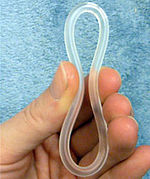Birth control vaginal ring
| NuvaRing | |
|---|---|

NuvaRing is a flexible plastic ring.
|
|
| Background | |
| Type | Hormonal |
| First use | 2001 |
| Failure rates (first year) | |
| Perfect use | 0.3% |
| Typical use | 1.5 to 9% |
| Usage | |
| Duration effect | 4 weeks |
| Reversibility | 0–4 weeks |
| User reminders | Inserted for 3 weeks and then removed for 7 days |
| Advantages and disadvantages | |
| STI protection | No |
| Weight | No proven effect |
| Period advantages | Periods do not begin while ring is inserted. |
| Benefits | Easy insertion and removal, only requires action every 1–3 weeks. |
Contraceptive vaginal ring is a type of insert that is placed in the vagina for the purpose of birth control.
A number of types exist. One type is the ethinylestradiol/etonogestrel vaginal ring, also known as NuvaRing. It is a flexible plastic (ethylene-vinyl acetate copolymer) ring that releases a low dose of a progestin and estrogen over three weeks. It is currently used by approximately 1.5 million women worldwide.
A progesterone vaginal ring has also been developed. It is specifically made for use during breast feeding as it does not affect milk production.
...
Wikipedia
